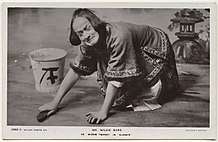Wilkie Bard
Wilkie Bard (born William August Smith) (19 March 1874 – 5 May 1944) was a popular British vaudeville and music hall entertainer and recording artist at the beginning of the 20th century. He is best known for his songs "I Want to Sing in Opera" and "The Night Watchman".
Wilkie Bard | |
|---|---|
 Bard as Widow Twanky in Aladdin, c. 1906 | |
| Background information | |
| Birth name | William August Smith |
| Born | 19 March 1874 Chorlton-cum-Hardy, Manchester, England |
| Died | 5 May 1944 (aged 70) Buckinghamshire, England |
| Genres | vaudeville, music hall |
Early life
Bard was born in Chorlton-cum-Hardy, Manchester, Lancashire.[1] He began as an amateur singer and comedian, aged 21, and his acts included the part of a coon singer[2] and a character who had a bald head and who wore a black spot on each eyebrow.[3] He also performed in female character roles, specifically with his hit song "I Want to Sing in Opera".[4] Bard had a long career in pantomime[2] and introduced tongue twisters such as "She sells seashells by the seashore", based on a song he performed in the show "Dick Whittington and His Cat" in Drury Lane in 1908. In 1919 he went to America where he performed in vaudeville,[5] making his debut at the Palace Theatre on 20 October that year; the show was not well received.[6] He stayed with the production and after a few alterations to the script, he became a hit.[7]
He performed in Australia in 1921.[8] In 1923, Bard appeared with Jack Pearl in tests for Lee de Forest's sound-on-film process Phonofilm. This short film is in the collection of the UCLA Film and Television Archive. In 1928, Bard appeared in two short films made in Phonofilm, The Cleaner and The Night Watchman, which may be in the collection of the British Film Institute.[9]
Personal life
Bard was married to Ellen Smith (née Stratton), who performed using the stage name Nellie Stratton. The 1881 and 1891 UK census returns show her name to be Nellie from birth (Peckham, London 1875).[10]
Death
Bard died in 1944 at the age of 70 in Buckinghamshire following a coronary thrombosis.[11]
References
- "Old Music Halls", The Stage, 21 January 1951, p. 4.
- "Song on Balcony", Sunderland Daily Echo and Shipping Gazette, 8 August 1939, p. 6.
- "Excursions",Worthing Herald, 26 May 1939, pp. 17–18.
- "Wilkie Bard: Dutchman. Mr. Wilkie Bard in "My Little Deutsche Girl", one of his littlest successes", Penny Illustrated Paper, 7 December 1907, p. 3.
- "Hammerstein Signs Wilkie Bard", New York Times, 3 June 1913, p. 3.
- "The Play by Alexander Woolcot, The New York Times, 21 October 1919.
- "Wilkie Bard Reappears", The New York Times, 24 October 1919.
- "Wilkie Bard, famous English comedian here", Sydney Morning Herald, 19 July 1921, p. 12.
- IMDB entry
- 1891 UK census return RG12/119
- "Death of Mr Wilkie Bard, Aberdeen Press and Journal, 6 May 1944, p. 1.
External links
- Wilkie Bard on IMDb